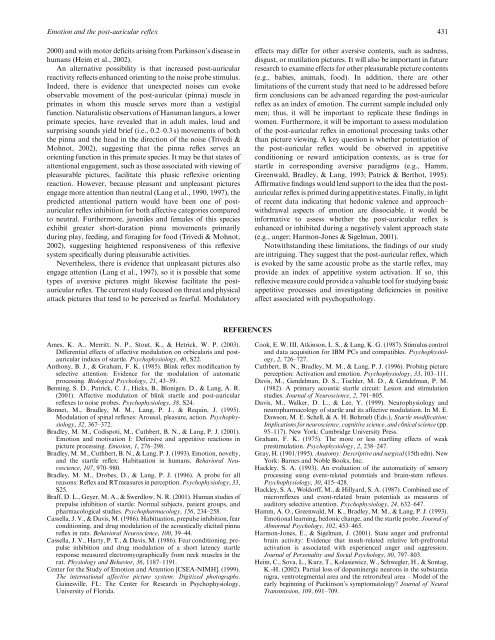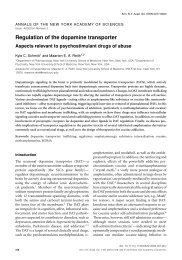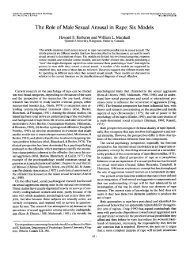Emotional modulation of the postauricular reflex
Emotional modulation of the postauricular reflex
Emotional modulation of the postauricular reflex
You also want an ePaper? Increase the reach of your titles
YUMPU automatically turns print PDFs into web optimized ePapers that Google loves.
Emotion and <strong>the</strong> post-auricular <strong>reflex</strong> 431<br />
2000) and with motor deficits arising from Parkinson’s disease in<br />
humans (Heim et al., 2002).<br />
An alternative possibility is that increased post-auricular<br />
reactivity reflects enhanced orienting to <strong>the</strong> noise probe stimulus.<br />
Indeed, <strong>the</strong>re is evidence that unexpected noises can evoke<br />
observable movement <strong>of</strong> <strong>the</strong> post-auricular (pinna) muscle in<br />
primates in whom this muscle serves more than a vestigial<br />
function. Naturalistic observations <strong>of</strong> Hanuman langurs, a lower<br />
primate species, have revealed that in adult males, loud and<br />
surprising sounds yield brief (i.e., 0.2–0.3 s) movements <strong>of</strong> both<br />
<strong>the</strong> pinna and <strong>the</strong> head in <strong>the</strong> direction <strong>of</strong> <strong>the</strong> noise (Trivedi &<br />
Mohnot, 2002), suggesting that <strong>the</strong> pinna <strong>reflex</strong> serves an<br />
orienting function in this primate species. It may be that states <strong>of</strong><br />
attentional engagement, such as those associated with viewing <strong>of</strong><br />
pleasurable pictures, facilitate this phasic <strong>reflex</strong>ive orienting<br />
reaction. However, because pleasant and unpleasant pictures<br />
engage more attention than neutral (Lang et al., 1990, 1997), <strong>the</strong><br />
predicted attentional pattern would have been one <strong>of</strong> <strong>postauricular</strong><br />
<strong>reflex</strong> inhibition for both affective categories compared<br />
to neutral. Fur<strong>the</strong>rmore, juveniles and females <strong>of</strong> this species<br />
exhibit greater short-duration pinna movements primarily<br />
during play, feeding, and foraging for food (Trivedi & Mohnot,<br />
2002), suggesting heightened responsiveness <strong>of</strong> this <strong>reflex</strong>ive<br />
system specifically during pleasurable activities.<br />
Never<strong>the</strong>less, <strong>the</strong>re is evidence that unpleasant pictures also<br />
engage attention (Lang et al., 1997), so it is possible that some<br />
types <strong>of</strong> aversive pictures might likewise facilitate <strong>the</strong> <strong>postauricular</strong><br />
<strong>reflex</strong>. The current study focused on threat and physical<br />
attack pictures that tend to be perceived as fearful. Modulatory<br />
Ames, K. A., Merritt, N. P., Stout, K., & Hetrick, W. P. (2003).<br />
Differential effects <strong>of</strong> affective <strong>modulation</strong> on orbicularis and <strong>postauricular</strong><br />
indices <strong>of</strong> startle. Psychophysiology, 40, S22.<br />
Anthony, B. J., & Graham, F. K. (1985). Blink <strong>reflex</strong> modification by<br />
selective attention: Evidence for <strong>the</strong> <strong>modulation</strong> <strong>of</strong> automatic<br />
processing. Biological Psychology, 21, 43–59.<br />
Benning, S. D., Patrick, C. J., Hicks, B., Blonigen, D., & Lang, A. R.<br />
(2001). Affective <strong>modulation</strong> <strong>of</strong> blink startle and post-auricular<br />
<strong>reflex</strong>es to noise probes. Psychophysiology, 38, S24.<br />
Bonnet, M., Bradley, M. M., Lang, P. J., & Requin, J. (1995).<br />
Modulation <strong>of</strong> spinal <strong>reflex</strong>es: Arousal, pleasure, action. Psychophysiology,<br />
32, 367–372.<br />
Bradley, M. M., Codispoti, M., Cuthbert, B. N., & Lang, P. J. (2001).<br />
Emotion and motivation I: Defensive and appetitive reactions in<br />
picture processing. Emotion, 1, 276–298.<br />
Bradley, M. M., Cuthbert, B. N., & Lang, P. J. (1993). Emotion, novelty,<br />
and <strong>the</strong> startle <strong>reflex</strong>: Habituation in humans. Behavioral Neuroscience,<br />
107, 970–980.<br />
Bradley, M. M., Drobes, D., & Lang, P. J. (1996). A probe for all<br />
reasons: Reflex and RTmeasures in perception. Psychophysiology, 33,<br />
S25.<br />
Braff, D. L., Geyer, M. A., & Swerdlow, N. R. (2001). Human studies <strong>of</strong><br />
prepulse inhibition <strong>of</strong> startle: Normal subjects, patient groups, and<br />
pharmacological studies. Psychopharmacology, 156, 234–258.<br />
Cassella, J. V., & Davis, M. (1986). Habituation, prepulse inhibition, fear<br />
conditioning, and drug <strong>modulation</strong> <strong>of</strong> <strong>the</strong> acoustically elicited pinna<br />
<strong>reflex</strong> in rats. Behavioral Neuroscience, 100, 39–44.<br />
Cassella, J. V., Harty, P. T., & Davis, M. (1986). Fear conditioning, prepulse<br />
inhibition and drug <strong>modulation</strong> <strong>of</strong> a short latency startle<br />
response measured electromyographically from neck muscles in <strong>the</strong><br />
rat. Physiology and Behavior, 36, 1187–1191.<br />
Center for <strong>the</strong> Study <strong>of</strong> Emotion and Attention [CSEA-NIMH]. (1999).<br />
The international affective picture system: Digitized photographs.<br />
Gainesville, FL: The Center for Research in Psychophysiology,<br />
University <strong>of</strong> Florida.<br />
REFERENCES<br />
effects may differ for o<strong>the</strong>r aversive contents, such as sadness,<br />
disgust, or mutilation pictures. It will also be important in future<br />
research to examine effects for o<strong>the</strong>r pleasurable picture contents<br />
(e.g., babies, animals, food). In addition, <strong>the</strong>re are o<strong>the</strong>r<br />
limitations <strong>of</strong> <strong>the</strong> current study that need to be addressed before<br />
firm conclusions can be advanced regarding <strong>the</strong> post-auricular<br />
<strong>reflex</strong> as an index <strong>of</strong> emotion. The current sample included only<br />
men; thus, it will be important to replicate <strong>the</strong>se findings in<br />
women. Fur<strong>the</strong>rmore, it will be important to assess <strong>modulation</strong><br />
<strong>of</strong> <strong>the</strong> post-auricular <strong>reflex</strong> in emotional processing tasks o<strong>the</strong>r<br />
than picture viewing. A key question is whe<strong>the</strong>r potentiation <strong>of</strong><br />
<strong>the</strong> post-auricular <strong>reflex</strong> would be observed in appetitive<br />
conditioning or reward anticipation contexts, as is true for<br />
startle in corresponding aversive paradigms (e.g., Hamm,<br />
Greenwald, Bradley, & Lang, 1993; Patrick & Berthot, 1995).<br />
Affirmative findings would lend support to <strong>the</strong> idea that <strong>the</strong> <strong>postauricular</strong><br />
<strong>reflex</strong> is primed during appetitive states. Finally, in light<br />
<strong>of</strong> recent data indicating that hedonic valence and approach–<br />
withdrawal aspects <strong>of</strong> emotion are dissociable, it would be<br />
informative to assess whe<strong>the</strong>r <strong>the</strong> post-auricular <strong>reflex</strong> is<br />
enhanced or inhibited during a negatively valent approach state<br />
(e.g., anger; Harmon-Jones & Sigelman, 2001).<br />
Notwithstanding <strong>the</strong>se limitations, <strong>the</strong> findings <strong>of</strong> our study<br />
are intriguing. They suggest that <strong>the</strong> post-auricular <strong>reflex</strong>, which<br />
is evoked by <strong>the</strong> same acoustic probe as <strong>the</strong> startle <strong>reflex</strong>, may<br />
provide an index <strong>of</strong> appetitive system activation. If so, this<br />
<strong>reflex</strong>ive measure could provide a valuable tool for studying basic<br />
appetitive processes and investigating deficiencies in positive<br />
affect associated with psychopathology.<br />
Cook, E. W. III, Atkinson, L. S., & Lang, K. G. (1987). Stimulus control<br />
and data acquisition for IBM PCs and compatibles. Psychophysiology,<br />
2, 726–727.<br />
Cuthbert, B. N., Bradley, M. M., & Lang, P. J. (1996). Probing picture<br />
perception: Activation and emotion. Psychophysiology, 33, 103–111.<br />
Davis, M., Gendelman, D. S., Tischler, M. D., & Gendelman, P. M.<br />
(1982). A primary acoustic startle circuit: Lesion and stimulation<br />
studies. Journal <strong>of</strong> Neuroscience, 2, 791–805.<br />
Davis, M., Walker, D. L., & Lee, Y. (1999). Neurophysiology and<br />
neuropharmacology <strong>of</strong> startle and its affective <strong>modulation</strong>. In M. E.<br />
Dawson, M. E. Schell, & A. H. Bohmelt (Eds.), Startle modification:<br />
Implications for neuroscience, cognitive science, and clinical science (pp.<br />
95–117). New York: Cambridge University Press.<br />
Graham, F. K. (1975). The more or less startling effects <strong>of</strong> weak<br />
prestimulation. Psychophysiology, 2, 238–247.<br />
Gray, H. (1901/1995). Anatomy: Descriptive and surgical (15th edn). New<br />
York: Barnes and Noble Books, Inc.<br />
Hackley, S. A. (1993). An evaluation <strong>of</strong> <strong>the</strong> automaticity <strong>of</strong> sensory<br />
processing using event-related potentials and brain-stem <strong>reflex</strong>es.<br />
Psychophysiology, 30, 415–428.<br />
Hackley, S. A., Woldorff, M., & Hillyard, S. A. (1987). Combined use <strong>of</strong><br />
micro<strong>reflex</strong>es and event-related brain potentials as measures <strong>of</strong><br />
auditory selective attention. Psychophysiology, 24, 632–647.<br />
Hamm, A. O., Greenwald, M. K., Bradley, M. M., & Lang, P. J. (1993).<br />
<strong>Emotional</strong> learning, hedonic change, and <strong>the</strong> startle probe. Journal <strong>of</strong><br />
Abnormal Psychology, 102, 453–465.<br />
Harmon-Jones, E., & Sigelman, J. (2001). State anger and prefrontal<br />
brain activity: Evidence that insult-related relative left-prefrontal<br />
activation is associated with experienced anger and aggression.<br />
Journal <strong>of</strong> Personality and Social Psychology, 80, 797–803.<br />
Heim, C., Sova, L., Kurz, T., Kolasiewicz, W., Schwegler, H., & Sontag,<br />
K.-H. (2002). Partial loss <strong>of</strong> dopaminergic neurons in <strong>the</strong> substantia<br />
nigra, ventrotegmental area and <strong>the</strong> retrorubral area – Model <strong>of</strong> <strong>the</strong><br />
early beginning <strong>of</strong> Parkinson’s symptomatology? Journal <strong>of</strong> Neural<br />
Transmission, 109, 691–709.










